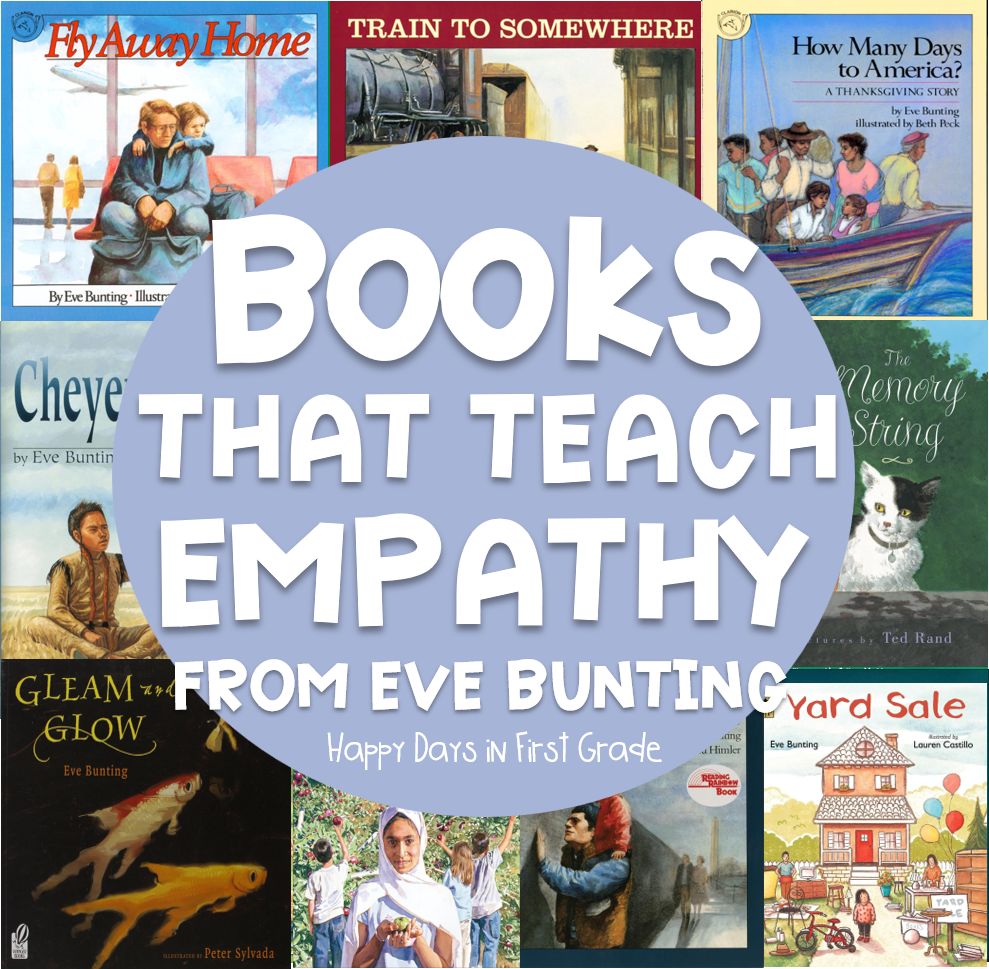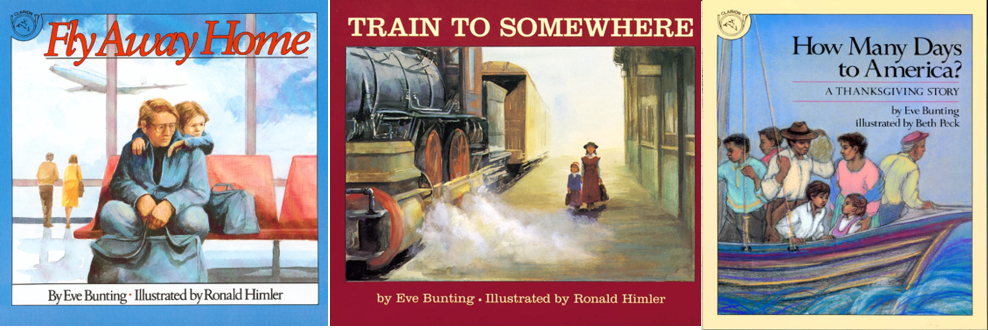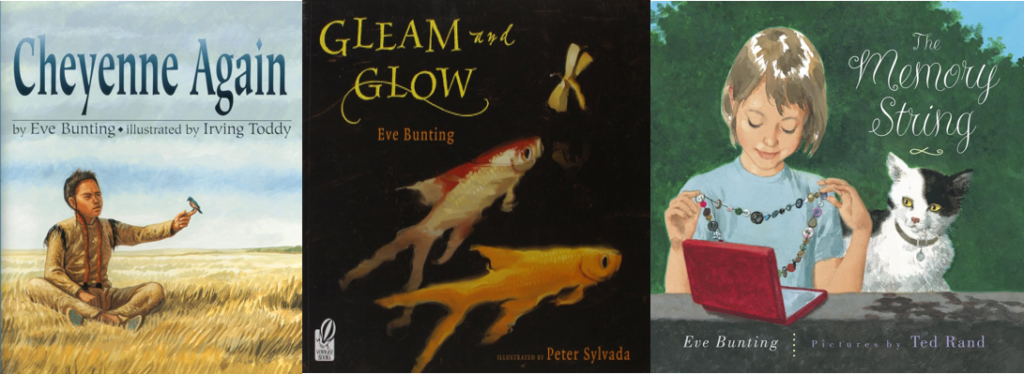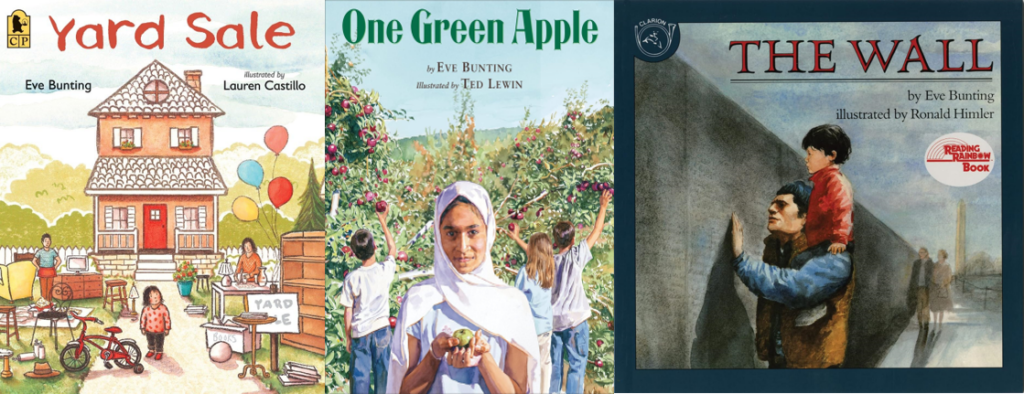One of my favorite lessons to teach is teaching empathy using Children’s books, especially Eve Bunting’s books. Her books are the perfect mentor texts to teach making connections and empathy to young readers. While some of the stories do not have happy endings as traditional Children’s books do, young learners must understand that this too is part of real life, realistic fiction, and loosely based on biographies.

Disclosure: Some of the links are affiliated links, meaning that I will earn a commission if you click through the links and make a purchase.

1. FLY AWAY HOME – This story describes the life of a little boy who is homeless and lives in an airport with his father and another family. During the day, they move around the terminals to avoid being noticed and getting caught by security. As the story goes on, the boy describes his daily activities and his hope of finding a new home for himself and his father. This book is a great way to help students understand what is homelessness and how it looks different from their impressions of homelessness. Students can easily make connections with the main character and share how blessed they are compared to him or even how similar they may be to him.
2. TRAIN TO SOMEWHERE –Marianne and her sister are on the Orphan Train to head out to the west. She is convinced that her mom will come back to get her and her little sister. However, when her mother doesn’t show up, she leaves on the train with fourteen other children to find families in the Midwest to love and take care of them. This story retells the stories of many orphaned, abandoned, and homeless children who once rode the Orphan Train from 1854 to 1929. I never really cried while reading to my students, but this story was hard to “keep together”. Not only did I get emotional reading and discussing this book with my students, but they also got very emotional listening to it. However, the conversations that came from this book were simply astonishing. My students six and seven years old were able to compare and contrast their lives with the characters of the story and expressed such sadness and compassion for them at the same time. We also talked about what it means to be orphaned and the plight that these children face daily.
3. HOW MANY DAYS TO AMERICA– No other time than now is the topic of refugees more important and relevant to discuss and teach young learners. That is why this book about a family escaping their war-torn country is a great mentor text to teach empathy. As I was reading this to my students, I asked them to make notes of connections that they have with the characters from this story and to share them throughout our reading time. For those students who were refugees themselves, they shared poignant personal stories and in turn, I also shared my personal story as a refugee. The students were surprised, intrigued, and gained so much perspective on how people become refugees and their need to find a new and better home.

4. CHEYENNE AGAIN- Every year when I teach about Thanksgiving, I, as many American primary school educators, talk about the friendship between the Native Americans and Pilgrims and how it helped create the First Thanksgiving. While that part of the story is historically accurate, what occurred afterward also needs to be taught even in the primary grades. Young children need to hear and learn from all sides of history, especially our history, even when it’s not all happy and doesn’t paint a perfect picture.
As we all know, the story and relationship between Native Americans and the Pilgrims/colonists, as a whole, was much more complicated than the Thanksgiving Story portrays. Therefore, this story about a little boy from the Cheyenne Tribe is extremely helpful and fitting to expose our children to our complex history as a nation with Native Americans.
This story recalls the period when Native American children were forced against their and their family’s will to boarding schools to assimilate into the white culture. When reading, I noticed that my students were visibly shocked and disheartened to see what was happening to Young Bull, the main character. However, our discussion on the ideas of justice, freedom, and our country’s ever-progressing journey to create a more perfect union helped my students the importance of learning from our past. After reading, my students were able to describe Young Bull’s character traits, compare and contrast their life with his, make connections, and infer what they thought would happen to Young Bull.
5. GLEAM & GLOW-I love reading this story along with How Many Days to America as there can be so many text-to-text connections made between the two books as well as opportunities throughout the stories to help young learners understand the journeys and lives of people in war-torn countries. Inspired by real-life events, Bunting describes of a family torn by the war in Bosnia and how these two goldfish brought back hope for the family and people around them.
7. YARD SALE– I have taught at a Title I school almost all of my career. Therefore, reading this story hits home for me and reminds me of my students who came from poverty or faced financial hardships at home. For students who are blessed and do not have to worry about losing their homes or having to sell their belongings to live, this book will open up their eyes and have empathy for less fortunate children. However, the best part of this book is it’s not what you have, but who you have in your life that matters the most.

8. ONE GREEN APPLE– Farah is the new kid in class and finds herself alone and lonely. It’s hard to be in a new country and a new school and surrounded by a new language. When she goes with her class on a field trip to the farm, she finds things around the farm that are familiar to her. When she uses the apples from the farm to make apple cider with her classmates, she suddenly feels connected to them and less lonely. This sweet book allows students to see how it feels to be a new student and how they too can be kind and welcoming.
9. THE WALL– A father takes his son to the Vietnam Veterans Memorial to find their grandfather’s name and honor his service and memories. This book is beautiful and emotional and is told from the child’s perspective as he never met his grandfather before.
If you need easy-to-use Reading Comprehension Printables to go along with these books or other mentor texts, click on the resource below.


